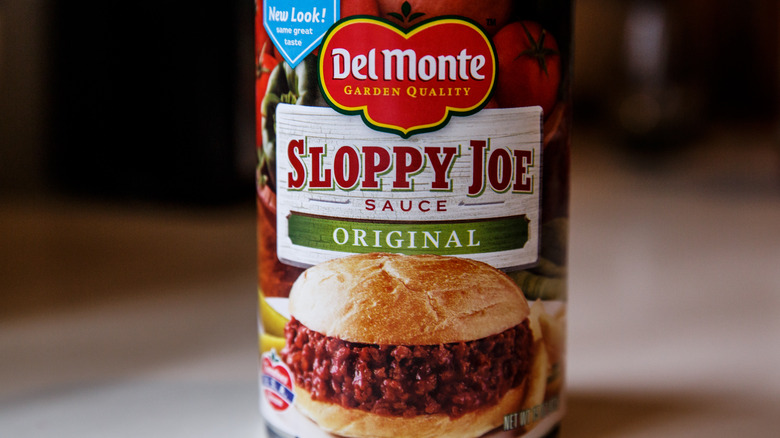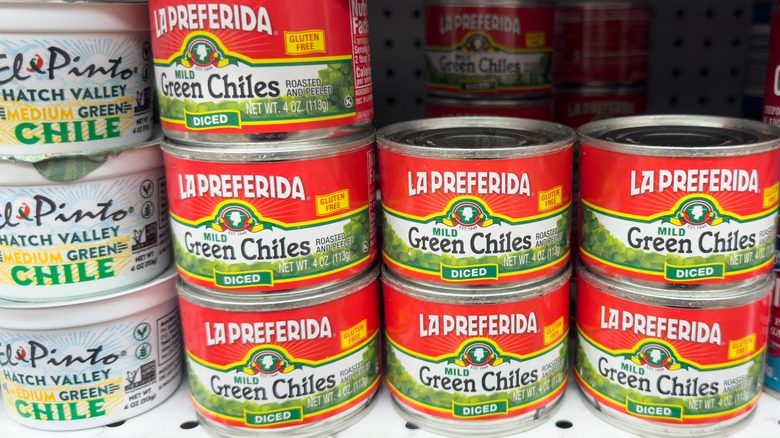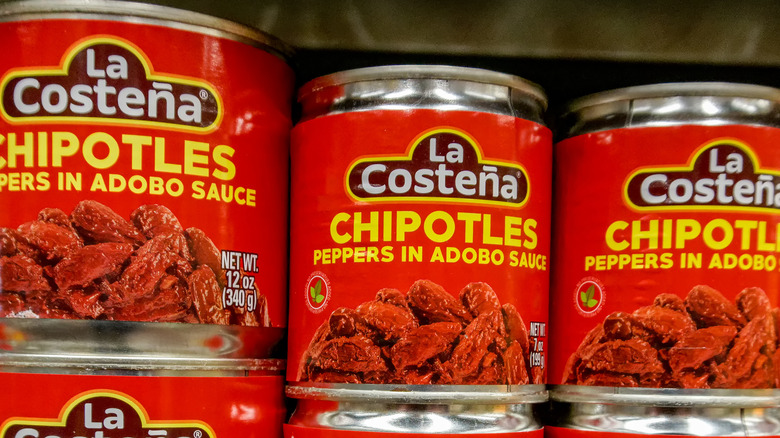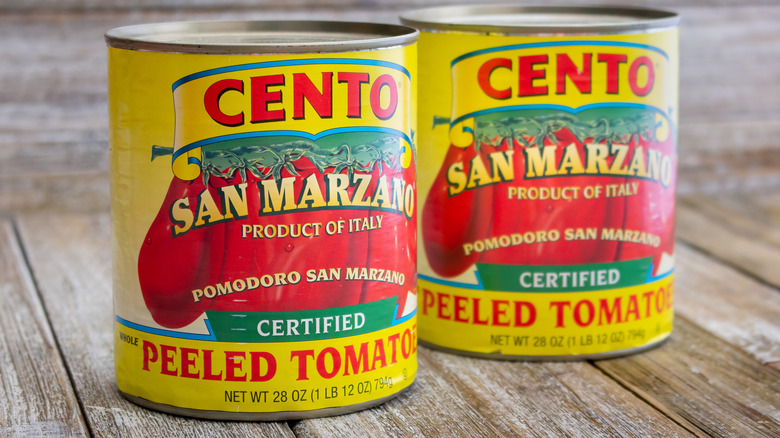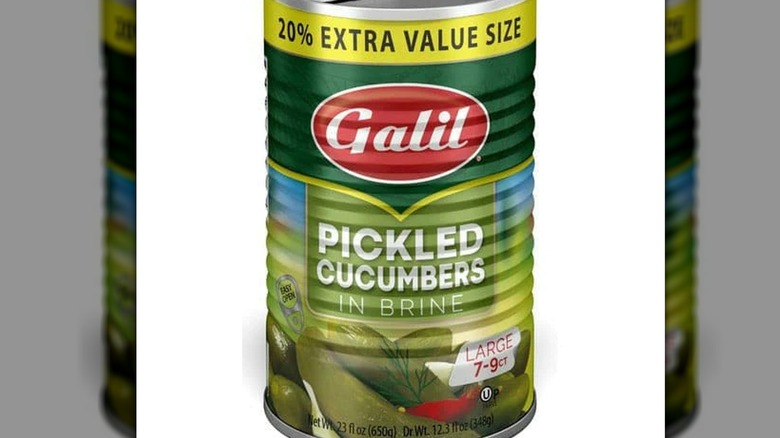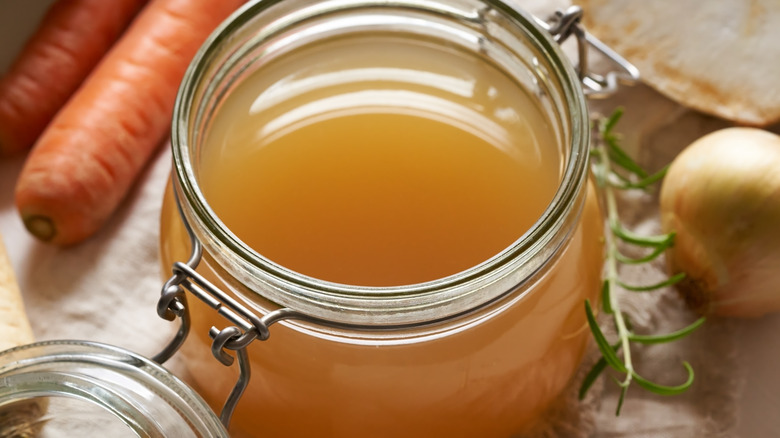Canned Ingredients That Will Seriously Upgrade Your Chili
If you're short on time, you can buy a savory, hearty chili in a can to heat up in just a couple of minutes in the microwave or on the stove. But, nothing quite beats homemade chili, especially on a fall or winter's night. Chili is one of the most versatile dishes, allowing you to experiment with all the flavors and ingredients you want. Contrary to popular belief, you don't have to spend hours in the kitchen chopping ingredients to make a tasty chili.
That's because you can instead rely on canned foods to add the flavors you want while giving it a serious upgrade. We've pulled together a list of canned foods to make chili even better that extends well beyond the basic chili addition of canned beans. Some of the canned ingredients on our list might replace other ingredients you typically add to your chili to make the process faster, but others are unusual canned foods that you probably never thought about stirring into homemade chili. However, we promise they're worth a try.
Sloppy joe sauce
Depending on the chili recipe you use, the base can vary significantly. Every chili uses some sort of liquid to give chili its stew-like texture, whether that's tomato juice, beef stock, or just plain water. One canned ingredient that you can use for a base might not be on your radar, yet it can truly kick chili up a notch or five: sloppy joe sauce.
Sloppy joe sauce is traditionally used for sloppy joes, of course. When you grab a canned version, you get everything needed for sloppy joe sauce already combined, including the tomato puree, vinegar, and spices that give it its well-known flavor. Simply pour it from the can into your pan of sauteed veggies and ground beef, and you have a quick version of chili with tons of flavor. You can either leave the sloppy joe sauce as is or add some diced tomatoes and beans to your base for additional texture and a more tomato-infused taste.
Pumpkin puree
Looking for something to enhance your chili's texture without overpowering its flavors? Try canned pumpkin puree. Adding just a few tablespoons of pumpkin puree into a pot of chili can bring chili to the creamier side, giving it a delightful richness against the more liquidy texture of some chilis.
Pumpkin also has numerous health benefits that can boost the overall nutritional value of chili, like having an impressive amount of antioxidants and containing a broad mix of good-for-you vitamins. But, using fresh pumpkins in any kind of cooking can be a chore. Fortunately, canned pumpkin makes adding pumpkin to chili much easier.
Many canned pumpkin purees contain 100% pumpkin with no additional ingredients that counteract its health benefits. But be sure to look for ones without added sugar or spices, which are usually labeled for use as pumpkin pie filling. These sweeter versions could add flavors that don't mix well with your savory chili.
Ground coffee beans
If you want to enhance your chili in a way that others might not expect, look no further in your pantry than a can of ground coffee beans. That's right; your favorite morning drink could also become one of your new favorite additions to chili. Martin Phillip, the Baking Ambassador for King Arthur Baking Company tells Food & Wine, "Coffee brings depth to everything it touches, pairing well with chocolate, warming spices, savory rubs, crust treatments on [bread] loaves, or even treats like salty sweet pecan cookies," adding that it's also easy to customize how much coffee flavor you add just by adjusting the intensity of the coffee you use in your food.
For chili, specifically, coffee adds rustic, savory notes and complements the herbs and spices you include by strengthening their aromatics and flavors. Before you start dumping coffee grounds into your chili, we want to make it clear that we're discussing brewed coffee. Brew an eight-ounce cup of coffee, using as many grounds as you need for your preferred coffee strength. Then, slowly pour some into your batch of chili, stirring everything before taste testing. Continue adding more coffee in small amounts until you've hit the sweet spot of flavor.
Beer
Beer enthusiasts probably already know that cooking with beer is a thing that shouldn't be ignored, even if you're not a big fan of the beverage. Beer can be added to several types of dishes and flavoring agents, including sweets, breads, and marinades. It's especially useful for glazing meat with additional flavor besides the traditional salt and pepper, which can be good news for people who use ground beef or sausage in their chili.
Lots of people use beer in their chili, as evidenced in several Reddit threads discussing the best types of beer to use. For example, in one Reddit thread, chili makers discuss using chocolate porters for deep flavors, while many Redditors in another thread agree that there's no need to search for anything specific or expensive, as even cheap beers can upgrade chili tremendously.
How can you use beer effectively in chili? Add a small amount to the pan while cooking the meat. Once you finish browning the meat and sauteing the vegetables, drain off any excess liquid. Then, add your tomato sauce or other base ingredients and stir in the rest of the beer, bringing everything to a low boil. Stir, and reduce the heat to allow the chili to simmer.
Olives
Chili often contains many ingredients, like ground beef, tomato sauce, beans, and cheese. Some people even add banana peppers, jalapeños, or corn to their chili, depending on the flavor profile they're going for. So, why not add olives for something a little different?
Canned black or green olives could make your chili even better than you expected if you're willing to give them a shot. They can work especially well if you believe your finished chili dishes could usually use a little more salt, as olives naturally have a salty flavor that instantly kicks things up a notch. When canned, the salt level tends to increase even more, so just be careful not to add too much salt to your chili if you decide to incorporate olives. We also suggest buying pre-sliced, canned olives unless you don't mind slicing them yourself. Smaller chunks of olives can make them less overpowering in your chili, adding just a touch of flavor and texture to each bite.
Green chiles
Let's face it: Chili without any kind of peppers is kind of ... not chili. Depending on the kind of peppers you use, peppers can add crunch, texture, flavor, and spice to chili. With thousands of types of peppers grown worldwide, that makes virtually endless possibilities to craft unique flavor profiles with chili.
However, we know that not everyone wants to add heat to their chili, which is where canned green chiles come into play. Green chiles have just a mild spice that, when added carefully, will barely raise the heat level of your chili. You can specifically look for diced green chiles in a can, which are cut into tiny portions so that there are no big chunks of spice in your bowl. The best part is that, although mild in spiciness, green chiles add some texture to chili while enhancing its flavors.
One Redditor suggests roasting green chiles with whatever other peppers you'd like to add to boost their flavor — it'll give them a toasty, smoky taste — for use as a mouthwatering chili base. Another home cook on Reddit likes using green chiles in white chicken chili to add to its flavor, which is often more muted than traditional chili.
Chipotle peppers in adobo sauce
If you prefer to add enough spice to your chili that you feel a little zing in your mouth and on your lips when eating it, try adding chipotle peppers. Chipotle peppers still aren't the spiciest peppers you'll find, but they're not the mildest, either. Instead, they offer a good balance between "Where's the heat?" and "Why can't I feel my mouth?"
You can buy them fresh, but we absolutely love canned chipotle peppers in adobo sauce for our chili recipes. Adobo sauce is a Mexican ingredient often used as a condiment, like for dipping veggies into or drizzling on top of tacos. It has loads of flavor from spices like ancho chili powder and cumin, all of which transfer over to chipotle peppers when they're combined in a can. Chipotle peppers with adobo sauce work as an excellent base for chili. Just pour a can or two into your pot after sauteing your vegetables and meat, along with whatever beans, tomatoes, and other ingredients you're including.
San Marzano tomatoes
There's a reason that many recipes calling for canned tomatoes specifically suggest using San Marzano tomatoes. San Marzano tomatoes are a type of plum tomato known for their balanced acidity and hint of sweetness, lending well to dishes with tomato sauce, like spaghetti, or that require tomato bases without the overwhelming flavor of tomato, like chili. Additionally, these tomatoes aren't overloaded with seeds, so you get more tomato flesh in your chili.
San Marzano tomatoes are available fresh in some supermarkets, but buying them canned offers a few benefits. First, they're already peeled, so you won't have to spend extra time removing the skin before adding them to the chili pot. Second, they're already softened, allowing you to quickly stir them into your chili rather than cooking them down first. Finally, research from a 2022 study published in Advances in Nutrition shows that canned tomatoes may have even more nutrients than their fresh versions, especially lycopene, which has links to cancer prevention and heart health.
Carrots
We're aware that this canned ingredient idea for chili could come with a lot of backlash, but hear us out. Canned carrots are subtly sweet, just enough to help balance the acidity and spiciness of chili. And, when you choose the sliced canned version over fresh carrots, you don't have to go through the lengthy process of peeling, slicing, and cooking the carrots yourself before adding them to chili. Simply open the can, drain the liquid, and pour them into the pot.
If you still don't believe us that carrots are at least a worthy try-it ingredient, consider this Reddit post, where the original poster highlights their chili recipe, asking others whether adding carrots is a good idea. Although there were a few Redditors who said they absolutely wouldn't add carrots to their chili, there were also several who said, "yes, do it!" For instance, this commenter admits to always using carrots in vegetarian chili, while another respondent states, "I'm usually down for loading things with veggies, so long as they work well within the recipe. I think carrots work okay here."
Pickle juice
There are two types of people on the planet: Those who pour leftover pickle juice from jarred and canned pickles down the drain and those who would never think to waste such a precious ingredient. In fact, some people happily drink pickle juice. Pickle juice can also add tanginess to some of your favorite dishes, like macaroni salad, potato salad, and fried chicken.
Chili might not be one of those dishes where a little tanginess seems appropriate, but you might be surprised by what a little splash of it can do in a batch of chili. Chili is usually a very savory dish with intense flavors, most of which are very rich. Pickle juice can cut down that richness a bit, adding lighter, brighter flavors.
Some people will disagree that pickle juice belongs anywhere near chili, as evidenced by one Reddit thread discussing whether an employee was wrong for tossing some in a pot of chili for a staff meal. However, several agreed that it was smart to give it a try, and the original poster admitted "it was delicious."
Beef broth
There are three reasons why you should add canned beef broth to your chili. First, if you prefer to load your chili up with vegetables and beans rather than ground beef, the addition of beef broth is a good alternative. It adds traditional beef flavors to the dish without creating more texture with bits of ground beef. Second, beef broth can be one of the prime ingredients you use as your base. Combine it with tomato juice, roasted peppers, and whatever other ingredients you use as a chili base to pull it all together while infusing extra flavor into the dish.
Finally, keeping beef broth on hand when making chili allows you to adjust its texture as you cook it. Sometimes, chili thickens as it simmers or cooks in the slow cooker for hours, depending on the ingredients you've used for the base. If you notice it gets a little thicker than you'd like, simply splash in some beef broth instead of water. It thins out the base without watering down its flavors.
Root beer or cola
Did you know that cola or root beer can upgrade your chili? When used as part of a chili base — usually as a substitute for part of other liquids, like water or broth — it adds a whole new layer of flavor to chili that elevates the other ingredients and spices you use. Try splashing in a few tablespoons as you create your base or as you're browning ground beef to incorporate the unique tastes that these sodas offer. If you prefer chili that's on the sweeter end of the scale, then this might just be the trick you need. If you've ever had a cola-infused barbecue sauce, you know how delicious bold and sweet flavors can be when they come together.
When making chili, one Reddit user suggests making a small batch on the side to experiment with. This small batch is what you can use to pour in cola or root beer, taste test, and add a little more until you reach your flavor goals. Or, if you don't love the infusion, scrap the small batch altogether without ruining or wasting your main batch.

